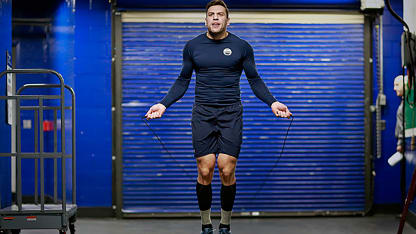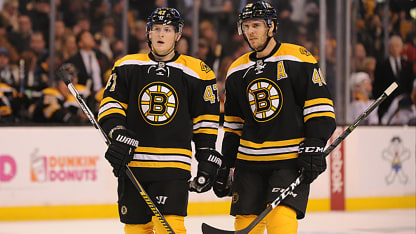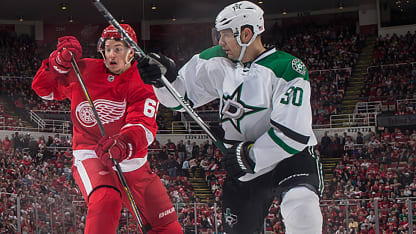The scent wafts over to David Backes during team dinners, and his mouth waters. He remembers the taste of filet mignon keenly, the tang of the iron, the chew of the meat, the satisfaction from a well-cooked steak. But these days, it doesn't go any further. Instead the Boston Bruins forward tucks into his own meal at these dinners, something plant-based, or more likely a piece of wild-caught salmon.
Faster NHL has players turning to weight loss, nutrition to keep up
Veterans change routines hoping to 'stay relevant and stay productive'

This is his NHL career on the line, after all. Eating this way could be the difference between playing out the rest of his hefty contract -- it runs three more seasons, including this one, at an average annual value of $6 million -- as a contributor or as a spare part. Backes hopes it is the former and, to get there, he is willing to forgo the foods that were once his lifeblood.
"I'm salivating," Backes said. "But I know it's better for me to stick with the omega-3s in the piece of salmon than it is to bury a 16-ounce steak."
Backes was on a mission last offseason, to get leaner, to bring his 222-pound frame more in line with where it should be in the current NHL. He shed 10 pounds in an effort to reclaim the game that enticed the Bruins to sign him to that five-year, $30 million contract July 1, 2016, after 10 seasons with the St. Louis Blues.
It's a story that's becoming common across the NHL, especially among veterans, especially among bigger players, as they try to hold on to what once made them an integral part of the NHL. They have watched the players around them grow smaller and lighter and faster, and they acknowledge they need to do the same -- if they can.
Because the NHL is shrinking.
Fourteen seasons ago, in 2003-04, the average weight in the NHL was 206.41 pounds. This season, it has dipped below 200, to 199.54. And though the average height has also dipped, from 6-foot-1.24 in 2003-04 to 6-1.05 this season, it's not enough to account for the weight loss.
In 2003-04, there were 117 players in the NHL weighing at least 225 pounds; 17 of them were at least 6-6. Five years later, there were about the same number, 113, weighing 225. But by 2013-14 the number had dropped to 81, and this season it stands at 41, with seven of those players at least 6-6.
"I do believe there's been a movement away from a boxier-type build in a player," Boston general manager Don Sweeney said. "The game is so fast. If you can't move, you get left behind."
Vancouver Canucks general manager Jim Benning said, "It's going to be harder and harder going forward with the speed of the League to find big-bodied guys that can keep up with the pace."

© Steve Babineau/Getty Images
Boston Bruins forward David Backes is among the NHL veterans who believe they need to watch their weight in order to keep up with younger, faster players.
Which is why Backes took up the cause in the offseason, thinking back to when he lost 10 pounds after he had diverticulitis, or intestinal inflammation, the previous fall. He was surprised to find that he felt better on the ice in the wake of the illness, and played some of his best hockey, scoring 14 points (seven goals, seven assists) in 15 games after his return. In the other 42 games he played, he scored 19 points (seven goals, 12 assists).
He gained the weight back over the rest of the season, then set about losing it again; if he really had played better because he was lighter, he believed he needed to permanently lose the weight and recapture the magic of being quicker and faster.
Plus the Bruins asked him to do it.
"It was an eye-opening experience that maybe there's a chance to play a little lighter," said the 34-year-old, whose production has dropped from 58 points (26 goals, 32 assists) with the Blues in 2014-15 to 13 points (five goals, eight assists) in 40 games this season.
"That makes you feel a little bit like you're staying on top of the ice and not worn down during the game. Just conversations with (coach) Bruce Cassidy and the management of, 'You have to stay healthy, but you've got to also keep up with the play and you're not getting younger and you're probably not getting faster,' just naturally by the aging process. So I had to do something concertedly."
But though Backes might be one of the more notable examples, he's far from the only one. Players like Dallas Stars forward Jason Spezza, Edmonton Oilers forward Milan Lucic and Detroit Red Wings forward Justin Abdelkader have tried -- some gradually, some all at once, some successfully, some less so -- to get more in line with where the NHL is.
It has shrunk. So they have shrunk. Or tried to, as least.
Because they know that if they don't, they might be rendered obsolete.
\\\\

© Bruce Bennett/Getty Images
When Erik Karlsson was drafted by the Ottawa Senators in 2008, the slight defenseman looked more like a stickboy than an NHL player, said Dallas Stars forward Jason Spezza, who was then with Ottawa.
Spezza remembers looking at Erik Karlsson and marveling.
Back then, at the time of the 2008 NHL Draft, Spezza was a member of the Ottawa Senators and Karlsson was the their first-round pick (No. 15), a Lilliputian 5-11 and 165 pounds, at least compared to some of the defensemen drafted ahead of him that year (Drew Doughty, who was 6-0, 219 at the time; Zach Bogosian, 6-2, 197; Alex Pietrangelo, 6-3, 206).
"This is who we drafted?" Spezza remembered thinking. "He looks like a stickboy. And now he's the best defenseman in the world, right? It was a definite shift."
Karlsson is no longer that size, listed at 6-0, 190. But his frame fits perfectly these days, with the smaller, more mobile, more offensive breed of defenseman coveted by general managers throughout the League.
In the new NHL, Calgary Flames forward Johnny Gaudreau (5-9, 165) and Tampa Bay Lightning center Brayden Point (5-10, 166) each is in the top 10 in points. (Gaudreau is second with 74; Point is seventh with 64.) Five of the 14 defensemen in the top 31 on NHL Central Scouting's final list of North American skaters ahead of the 2018 NHL Draft were shy of 6 feet.
Fast is good. Quick is good. Size can still be good.
But not always. It's not what teams are looking for first anymore.
"The top five picks when I got drafted (No. 2 in 2001, by the Senators) had to be 6-3 and play at 210, 220," said the 35-year-old Spezza, who lost about 12 or 13 pounds from his 6-3, 222-pound frame three years ago at the suggestion of then-Stars coach Lindy Ruff and who now plays at 215. "Now the top picks are 6-foot-1 and 175 pounds and look like they could work for the team.
"When I was young, we squatted every day, all day. Because you wanted to have a big [rear] and big legs and that's what made a hockey player."
Now, to be a hockey player, it's less about squatting, less about steak, more about yoga and Pilates, and even more about ginger-and-turmeric shots and tart cherry juice and wild Alaskan salmon and so, so, so many avocados.
Because you change or, as Backes said, "You become a dinosaur and become extinct.
"That's your choice. I'm going to be stubborn and stay on my train tracks, or I'm going to flip the switch and try to get on the right track so I can stay relevant and stay productive and stay doing what I love to do."
\\\\
For nearly a decade, Backes watched as his wife, Kelly, concocted meals for herself.
They cooked separately, Kelly with her plant-based menu -- with fish added now that the family is on the East Coast -- and David with his meat-and-potatoes-heavy diet.
Then came last offseason.

© Ilya S. Savenok/Getty Images
Boston Bruins forward David Backes has adopted a plant-based diet from his wife, Kelly.
"Adopting her lifestyle, her dietary regimen, was simple to do because she's already cooking it," Backes said. "And I tasted most of it and it wasn't terrible. … So it was an easy transition for me because she was already doing it and pointing the family in that direction. Our kids are both [eating] plant-based [diets] and thriving. My 3-year-old daughter looks like a 5-1/2-year-old. She's growing at an alarming rate."
He followed up that switch by eliminating added sugars, including in dried mangos and other seemingly healthy foods. That transition was more difficult.
"I had withdrawal symptoms for 10 days, maybe two weeks, of just a headache that wouldn't go away," he said. "I'm like, this was a problem. I was telling her what I was eating: fruit snacks and Rice Krispies Treats and little -- 'Oh it's right there, I'm going to have a couple.' Oreos are dessert after dinner.
"Now you start to boil that down. How many useless calories was I consuming?"
They didn't go cold turkey. There is still the occasional Sunday afternoon ice cream with the kids. There's the occasional bite of meat, some chicken in chicken soup, a cheat meal every now and then. But Backes took a hard look at what he was eating, and soon enough, 10 pounds vanished.
That's the general approach for those who want to shed weight, especially those who are already among the best of the best in the realms of fitness and health. But there are different ways to go about it, from plant-based diets to vegan to gluten-free to the elimination of red meat.
NHL teams have employed dieticians for the past decade or so, with Lisa McDowell of the Detroit Red Wings one of the longest-tenured at 10 years. She's seen players grow more adept at monitoring their intakes, though she has to watch out for the European players and their alfredo sauce, and the Swedes and their bearnaise sauce; neither complies with her idea of a balanced diet. (Detroit defenseman Jonathan Ericsson is so dedicated to the sauce that he launched his own line, Ericssson's Bearnaise.)
She has seen the next generation come in with the concept of eating healthy already established and has seen the older generation learn to accommodate her wishes. Her 15-ingredient morning smoothies, her ginger and blueberries and avocados and coconut and chia seeds and ground flaxseeds. Her sauteed spinach with pine nuts. Her sweet potatoes.
But for those interested in dropping weight, McDowell first strips the extras from their eating habits, those Oreos and Rice Krispies Treats and fruit snacks that Backes cut.
"What we would do is a really in-depth analysis of what they're typically taking in and you look for that 10, 20 percent fluff stuff," McDowell said. "It could be pretzel rods, maybe the beer, the ice cream, some of the foods in hockey that are pretty prevalent, and we look at how to kind of tweak. I think the offseason is the best time to periodize their nutrition regimen, so we try to dial it in then."
She might experiment with training players on a low-carbohydrate diet, might look at a concept called metabolic efficiency, an approach to training made popular by Bob Seebohar, who has been the sports dietician for the U.S. Olympic Committee. Metabolic efficiency training is a way of enhancing the ability to use the body's internal stores of nutrients. McDowell has taken players to Seebohar in Colorado Springs, Colorado, to see when they might be tapping into fat vs. carbohydrate stores, and to find a target heart rate number that enables them to burn fat specifically.
"There's all these tools available if guys express that interest of wanting to [lose weight]," McDowell said. "We want to balance power and speed for sure, and don't want to see them suffer in their game."
But that's a difficult balance, she said, "because you're looking at a two-percent margin. You're going to start to suffer at some point, right? It's such a narrow gap that you've got to be in the sweet spot."
And that sweet spot isn't easy to find.
"The game has gotten faster," Bruins sports nutritionist Julie Nicoletti said. "It continues to speed up and guys want to be as strong as they can, but still as quick as possible. They don't want to be too light and just get pushed around, but I also feel like they want to be quick.
"The old, thicker, bigger bodies, I think that's a thing of the past. They just get left in the dust."
\\\\
But weight loss is far from a cure-all. And that's for the players who can even lose the weight.
"We're all big guys that don't skate very well, right?" said the 35-year-old Spezza of a group that includes Backes, Lucic, Chicago Blackhawks defenseman Brent Seabrook and himself, among others. "So they want to tell us to lose weight because they think it's going to make us skate better. Is it?"
That's an important question.
For all of Backes' weight loss, and for all of the changes he's made, he has skated this season anywhere from the first to the fourth line, spending most of his time as a very-well-paid bottom-six right wing, and was a healthy scratch Wednesday for the first time since he became an NHL regular 12 years ago.
When Backes signed, he was regarded as a possible third-line center or top-line right wing. But neither of those options has panned out despite his physical evolution.
The weight loss has not brought him back to the way he played last season after first losing those 10 pounds. It has not brought the points or the role he wanted.
But perhaps thinking that weight loss alone would change things was shortsighted.
"There's still room as long as you can adapt," said Spezza, who scored an NHL career-high 92 points in 2007-08 but dipped to 50 in 2016-17 and 26 last season. He has 21 points (six goals, 15 assists) in 47 games this season. "I think it's more about adapting the style of the game than it is thinking you're going to become this little skinny guy. My legs aren't going to shrink all of a sudden. You're stuck with what you've got."
That was Lucic's problem.
The Oilers forward told Sportsnet midway through 2017-18 that he needed to slim down, acknowledging that his production wasn't what it once was. He had 34 points (10 goals, 24 assists) after routinely having 50- and 60-point seasons from 2010-11 through 2016-17.

© Jeff Vinnick/Getty Images
Edmonton Oilers forward Milan Lucic worked hard to get his weight down in hopes of raising his production.
And he tried in the offseason, but it wasn't quite that simple.
"It took me all summer just to get down to 230. I think I weighed in officially at 230.6," said the 30-year-old, who has played at 235 in past seasons. "It took me all summer of dieting and everything because I didn't want to lose my strength. I didn't want to lose my power. Especially because of the way I play, I need those things.
"There were times that I was weighing in at 227, 228 this year, and I felt almost exhausted. I felt almost dehydrated and exhausted. So you've got to find a balance of what works for your body."
The same thing happened to former linemate and current Bruins forward David Krejci. He is not exactly in the same category as some of the other, bigger-bodied players, but the 32-year-old knew he needed to work on his quickness and lose weight over the summer. Krejci dipped to 180 from his normal playing weight of 188, and fought the same exhaustion that Lucic faced, eventually settling in at the mid-180s. Lower, but not too low.
"I was like, I'm going to be awesome. I'm going to be flying. I'm going to be faster," said Krejci, who has 40 points (10 goals, 30 assists) in 49 games this season and is on pace for 66 points, his most since he had 69 in 2013-14. "But I kept it up for two weeks and every time I woke up, I was like, why am I so tired? I had no energy, because I was eating so little. Healthy but little.
"It's not just about losing weight. You've got to feel good."
That's the challenge.
Ultimately, Lucic decided that he wasn't interested in slimming down. Instead, he diagnosed that during the years when he played the best, his vertical leap made the difference. He spent the summer working on that to get his game back where he wanted it to be. But it has not helped; after scoring in a 5-2 loss to the Flames on Saturday, Lucic has 12 points (five goals, seven assists) in 48 games this season.
He's not alone, though, in believing that additional weight might be an asset, regardless of what the rest of the NHL is doing.
"We've had this conversation with (defenseman Torey) Krug," Cassidy said. "He's top-heavy, strong, loves to lift. It's like, Torey, what do you think? He says, 'I just feel better at that weight.' That's one he stayed at. Time will tell over his career which way he's going to have to go."
For his part, Krug (5-9, 186) was confused by the request to shed pounds. He plays a game similar to that of teammate Matt Grzelcyk (5-9, 174), a fellow puck-moving, offensive-minded defenseman. And at the same time they were asking if he would lose weight, the Bruins were encouraging Grzelcyk to gain some.
"I think their mentality was if I get a little bit lighter I could probably skate up and down the ice a little bit more," said Krug, who has played at both 183 and 188 pounds. "If you're carrying a few pounds less over time, it obviously goes a long way. Less weight to carry, less weight to move."
But that's not what feels best to him. He believes he needs the additional heft for energy later in the game, for battles in the corner, where he's already at a disadvantage, given his height. That was what he found when playing at the lower weight.
"I would like to hope that it's a good balance of player's preference and what the team wants, but ultimately as long as you perform, it doesn't matter," he said.

© Steve Babineau/Getty Images
Defenseman Torey Krug and forward David Krejci have seen the Boston Bruins begin providing healthier meals for players.
Still, it's not always an easy conversation to have. Weight is a tricky topic for the average person, and in some ways it's thornier for the average NHL player. And so with the Bruins having raised the topic with various players, they know that they might see acceptance, as with Backes, or resistance, as with Krug, or they might see denial entirely.
"It's hard," Cassidy said. "Sometimes it's immediately construed as a negative, right? I'm fat or I'm this or I'm out of shape. It's not necessarily that way. It's how do you keep your pace up, how do you recover quicker, and sometimes just being lighter will help."
Maybe.
"I think it's an absolute myth," Krug said. "Just because you're lighter, you probably lost muscle, now you're not as explosive. It's something that has to be balanced at some point."
\\\\
The Bruins practice at Warrior Ice Arena, their state-of-the-art facility in Brighton, Massachusetts, at the western edge of Boston. They are three seasons removed from practicing at Ristuccia Arena, a high-school-level facility north of the city, where the only lunch option was for players to order in takeout, usually pizza or subs.
"I kind of miss it every once in a while," Cassidy said, smiling.
That's easy for him to say, not having his livelihood depend on his quickness, agility and, sometimes, a number on a scale.
"It wasn't good but, at the time, everyone was doing that," Krejci said. "You didn't feel like you were doing anything wrong. But it's different. The League is faster and younger, so you've got to keep up. You've got to take care of your body."
Now all of the Bruins -- those looking to slim down, maintain, or even gain weight -- are greeted with chef-prepared, nutritionist-designed meals for breakfast and lunch on practice and game days, the ice cream sundae bar from TD Garden long gone, the food perfected to optimize performance and, in some cases, minimize weight, all arranged by Nicoletti, in her fourth season with Boston.
Nicoletti said she serves "whole real clean food in as close to its natural state as possible, as often as possible," whether it's for guys like Backes looking to drop pounds or someone like Grzelcyk, always trying to gain.
Because though the NHL is getting smaller and lighter, that's still not the case for every player. McDowell tells of Danny DeKeyser (6-3, 192), the Red Wings defenseman who has so much trouble keeping on weight that he's sometimes tasked with eating two or three avocados each day.
"I think the weight is overrated," Spezza said. "I think really the number is overrated. Too much gets made of the number because it's something we can quantify. For me, it's just eating properly and eating fats at the right time, eating carbs at the right times."

© Dave Reginek/Getty Images
Detroit Red Wings defenseman Danny DeKeyser has a hard time keeping weight on; Dallas Stars forward Jason Spezza thinks 'weight is overrated.'
Even eating red meat at the right times.
Spezza cut out all red meat at one point. He didn't feel quite right on the ice, perhaps because of a mental issue, perhaps a physical one, and eventually added it back into his diet. But he didn't add in the same jumbo cuts of ill-chosen beef, instead opting for smaller portions, for grass-fed, higher-quality meat.
It's all part of finding the balance. Finding the weight that works, the diet that works, the mix that can allow a dinosaur to still exist in a world of cheetahs. Much of the culling has already occurred, something that can be seen in the dwindling number of big bodies on the ice.
The rest? They aren't ready yet to be pushed out of a league that was once their domain.
"When I got to the League, even five years ago, it was kind of, 'Here's what we're going to do and we're going to just do it harder than you,'" Backes said. "It was stare across at you at the face-off dot, look the guy in the eye and say, 'I'm going to just do this game harder than you tonight.'"
That's not what the game is anymore. It's about who can get even a single step on the opponent, and who can use his speed to get to the puck, to get to the spot, to make the play. It's about gaining a foot where once it was about gaining an inch.
Players no longer need the same bulk to be able to stake out a space and hold it because that space isn't there anymore. It's moving, faster than they can keep up with, whether they're 5 pounds lighter or 10.
"You've got to be able to get in first on the forecheck and you've got to be able to get back on the backcheck and if you're carrying extra weight, it makes it a little harder to do," Lucic said. "So in five, 10 years, is there going to be a guy that's 6-3, 235 pounds? I can't answer that for you."

















